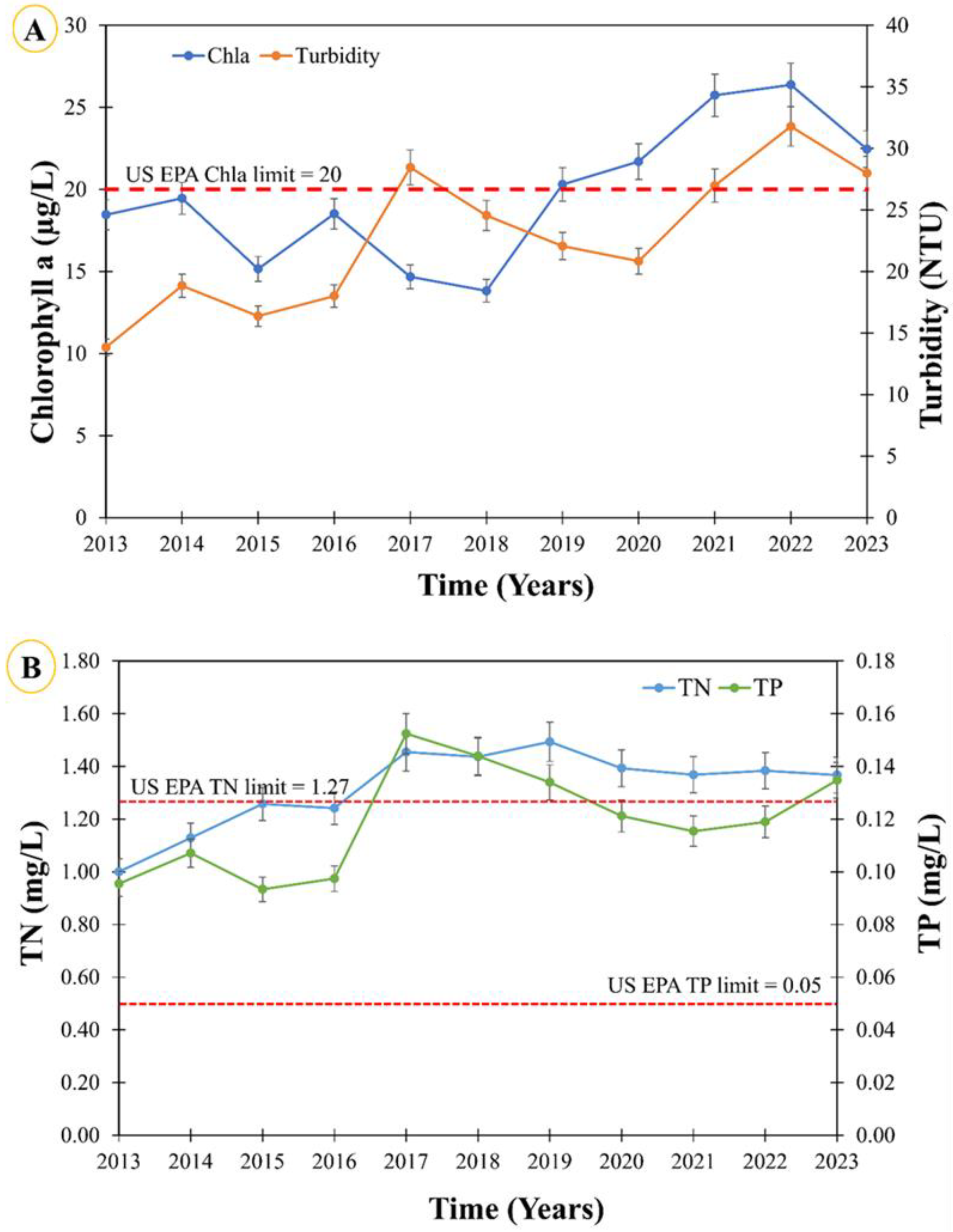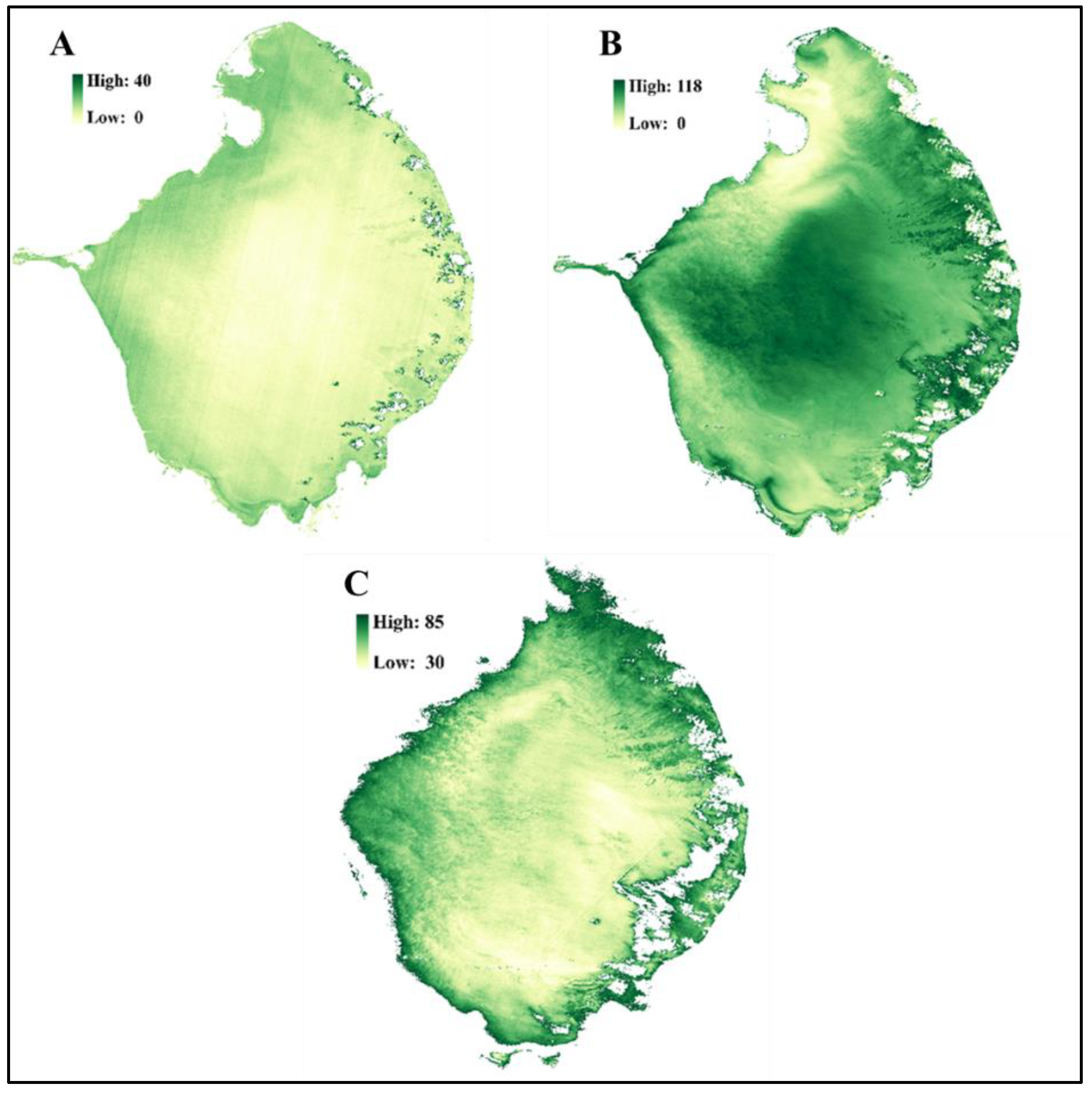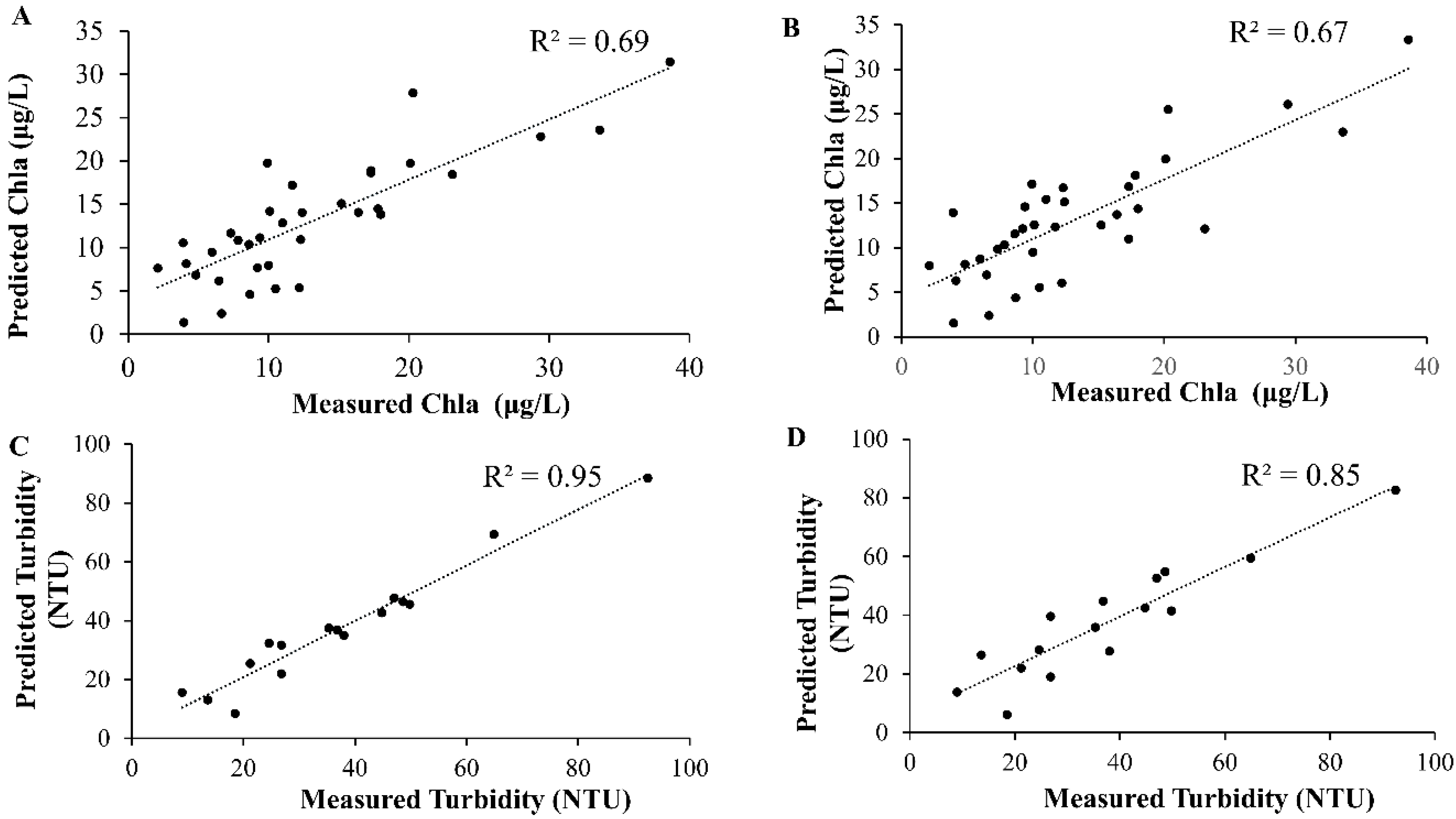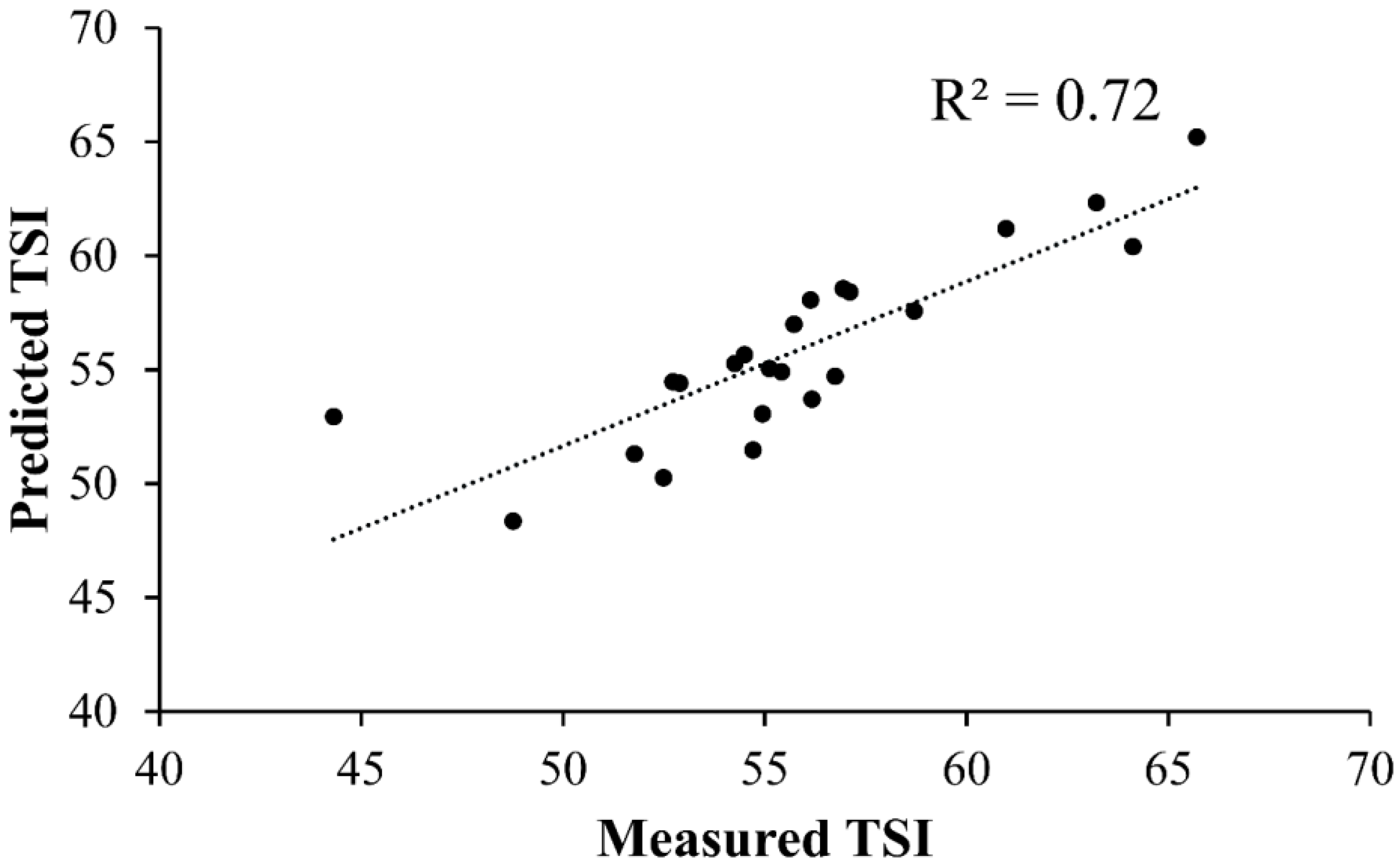Spatial and Temporal Dynamics of Water Quality in Lake Okeechobee Using Remote Sensing and Its Impact on Environmental Health
Abstract
1. Introduction
2. Methods
2.1. Study Area
2.2. Data Collection
2.2.1. In Situ Water Quality Data
2.2.2. Landsat Satellite Data
2.3. Data Processing
2.4. Statistical Analysis
2.4.1. Regression Models
2.4.2. Trophic State Index (TSI) Calculation
- Nutrient Balanced Lakes (10 ≤ TN/TP ≤ 30):
- Phosphorus-Limited Lakes (TN/TP > 30):
- Nitrogen-Limited Lakes (TN/TP < 10):
3. Results
3.1. In Situ Water Quality Parameters
3.2. Correlation Analysis Between In Situ Data and Landsat 8 and 9 Spectral Bands
3.3. Spatial Patterns from Predictive Models
3.4. Model Performance Summary
3.5. Validation and Application of Predictive Models
4. Discussion
4.1. On-Site Assessment of Water Quality Parameters
4.2. Remote Sensing Correlations and Model Performance
4.3. Spatial Patterns and Ecological Drivers
4.4. Applications for Management and Monitoring
4.5. Limitations and Future Directions
5. Conclusions
Author Contributions
Funding
Data Availability Statement
Acknowledgments
Conflicts of Interest
References
- Kiwanuka, M.; Mutanda, H.E.; Niyomukiza, J.B.; Nakasagga, E. Assessment of suitability of drinking water from the springs in Urban slums of Kampala. Environ. Chall. 2023, 10, 100667. [Google Scholar] [CrossRef]
- Oyege, I.; Katwesigye, R.; Kiwanuka, M.; Mutanda, H.E.; Niyomukiza, J.B.; Kataraihya, D.J.; Kica, S.; Egor, M. Temporal trends of water quality parameters, heavy metals, microplastics, and emerging organic pollutants in Lake Victoria and its basin: Knowns, knowledge gaps, and future directions. Environ. Nanotechnol. Monit. Manag. 2024, 22, 100962. [Google Scholar] [CrossRef]
- Wang, M.; Nim, C.J.; Son, S.; Shi, W. Characterization of turbidity in Florida’s Lake Okeechobee and Caloosahatchee and St. Lucie estuaries using MODIS-Aqua measurements. Water Res. 2012, 46, 5410–5422. [Google Scholar] [CrossRef] [PubMed]
- Paerl, H.W.; Paul, V.J. Climate change: Links to global expansion of harmful cyanobacteria. Water Res. 2012, 46, 1349–1363. [Google Scholar] [CrossRef]
- O’Neil, J.M.; Davis, T.W.; Burford, M.A.; Gobler, C.J. The rise of harmful cyanobacteria blooms: The potential roles of eutrophication and climate change. Harmful Algae 2012, 14, 313–334. [Google Scholar] [CrossRef]
- Lapointe, B.E.; Brewton, R.A.; McFarland, M.N.; Stockley, N. Nutrient availability in a freshwater-to-marine continuum: Cyanobacterial blooms along the Lake Okeechobee Waterway. Harmful Algae 2024, 139, 102710. [Google Scholar] [CrossRef]
- Zeman-Kuhnert, S.; Thiel, V.; Heim, C. Effects of Weather Extremes on the Nutrient Dynamics of a Shallow Eutrophic Lake as Observed during a Three-Year Monitoring Study. Water 2022, 14, 2032. [Google Scholar] [CrossRef]
- Canfield, D.E., Jr.; Bachmann, R.W.; Hoyer, M.V. Restoration of Lake Okeechobee, Florida: Mission impossible? Lake Reserv. Manag. 2020, 37, 95–111. [Google Scholar] [CrossRef]
- Paerl, H. Nutrient and Other Environmental Controls of Harmful Cyanobacterial Blooms Along the Freshwater–Marine Continuum. In Cyanobacterial Harmful Algal Blooms: State of the Science and Research Needs; Springer: New York, NY, USA, 2008; Volume 619, pp. 217–237. [Google Scholar]
- Duan, H.; Ma, R.; Xu, X.; Kong, F.; Zhang, S.; Kong, W.; Hao, J.; Shang, L. Two-decade reconstruction of algal blooms in China’s Lake Taihu. Environ. Sci. Technol. 2009, 43, 3522–3528. [Google Scholar] [CrossRef]
- Xu, Y.; Schroth, A.W.; Isles, P.D.; Rizzo, D.M. Quantile regression improves models of lake eutrophication with implications for ecosystem-specific management. Freshw. Biol. 2015, 60, 1841–1853. [Google Scholar] [CrossRef]
- James, R.T.; Pollman, C.D. Sediment and nutrient management solutions to improve the water quality of Lake Okeechobee. Lake Reserv. Manag. 2011, 27, 28–40. [Google Scholar] [CrossRef]
- Boggess, W.G.; Johns, G.; Meline, C. Economic impacts of water quality programs in the Lake Okeechobee watershed of Florida. J. Dairy Sci. 1997, 80, 2682–2691. [Google Scholar] [CrossRef]
- Hajigholizadeh, M.; Moncada, A.; Kent, S.; Melesse, A.M. Land–lake linkage and remote sensing application in water quality monitoring in lake okeechobee, Florida, USA. Land 2021, 10, 147. [Google Scholar] [CrossRef]
- McCormick, P.V.; James, R.T. Okeechobee, Lake, Florida, USA. In Encyclopedia of Lakes and Reservoirs; Bengtsson, L., Herschy, R.W., Fairbridge, R.W., Eds.; Springer: Dordrecht, The Netherlands, 2012; pp. 581–585. [Google Scholar]
- Chowdhury, R.R.; Rose, S.; Ezan, F.; Sovadinová, I.; Babica, P.; Langouët, S. Hepatotoxicity of cyanotoxin microcystin-LR in human: Insights into mechanisms of action in the 3D culture model Hepoid-HepaRG. Environ. Pollut 2024, 342, 123047. [Google Scholar] [CrossRef] [PubMed]
- Konst, H.; McKercher, P.; Gorham, P.; Robertson, A.; Howell, J. Symptoms and pathology produced by toxic Microcystis aeruginosa NRC-1 in laboratory and domestic animals. Can. J. Comp. Med. Vet. Sci. 1965, 29, 221. [Google Scholar] [PubMed]
- Li, T.; Fan, X.; Cai, M.; Jiang, Y.; Wang, Y.; He, P.; Ni, J.; Mo, A.; Peng, C.; Liu, J. Advances in investigating microcystin-induced liver toxicity and underlying mechanisms. Sci Total Environ. 2023, 905, 167167. [Google Scholar] [CrossRef]
- Carmichael, W.W. Health effects of toxin-producing cyanobacteria: “The CyanoHABs”. Hum. Ecol. Risk Assess. Int. J. 2001, 7, 1393–1407. [Google Scholar] [CrossRef]
- Dawson, R. The toxicology of microcystins. Toxicon 1998, 36, 953–962. [Google Scholar] [CrossRef]
- Vincent, R.K.; Qin, X.; McKay, R.M.L.; Miner, J.; Czajkowski, K.; Savino, J.; Bridgeman, T. Phycocyanin detection from LANDSAT TM data for mapping cyanobacterial blooms in Lake Erie. Remote Sens. Environ. 2004, 89, 381–392. [Google Scholar] [CrossRef]
- Schaefer, A.M.; Yrastorza, L.; Stockley, N.; Harvey, K.; Harris, N.; Grady, R.; Sullivan, J.; McFarland, M.; Reif, J.S. Exposure to microcystin among coastal residents during a cyanobacteria bloom in Florida. Harmful Algae 2020, 92, 101769. [Google Scholar] [CrossRef]
- Kramer, B.J.; Davis, T.W.; Meyer, K.A.; Rosen, B.H.; Goleski, J.A.; Dick, G.J.; Oh, G.; Gobler, C.J. Nitrogen limitation, toxin synthesis potential, and toxicity of cyanobacterial populations in Lake Okeechobee and the St. Lucie River Estuary, Florida, during the 2016 state of emergency event. PLoS ONE 2018, 13, e0196278. [Google Scholar] [CrossRef]
- Mokoena, M. Microcystins in water containers used in the home: A review of their potential health effects. Ecotoxicol. Environ. Saf. 2024, 269, 115787. [Google Scholar] [CrossRef]
- HealthCanada Guidelines for Canadian Recreational Water Quality Cyanobacteria and Their Toxins: Guideline Technical Document. 2022. Available online: https://www.canada.ca/en/health-canada/services/publications/healthy-living/guidance-canadian-recreational-water-quality-cyanobacteria-toxins.html (accessed on 25 October 2024).
- EPA. Water Quality Standards for the State of Florida’s Lakes and Flowing Waters. Retrieved from EPA Water: Regulatory Information. 2010. Available online: http://water.epa.gov/lawsregs/rulesregs/florida_factsheet.cfm (accessed on 20 July 2024).
- Baltodano, A.; Agramont, A.; Lekarkar, K.; Spyrakos, E.; Reusen, I.; van Griensven, A. Exploring global remote sensing products for water quality assessment: Lake Nicaragua case study. Remote Sens. Appl. Soc. Environ. 2024, 36, 101331. [Google Scholar] [CrossRef]
- Kintu, I.M.; Gidudu, A.; Letaru, L. Assessment of Lake Victoria’s Trophic Status Using Satellite-Derived Secchi Disk Depth. In Earth Observations and Geospatial Science in Service of Sustainable Development Goals: 12th International Conference of the African Association of Remote Sensing and the Environment; Springer: Cham, The Netherlands, 2019; pp. 79–87. [Google Scholar]
- Tang, Y.; Feng, Y.; Fung, S.; Xomchuk, V.R.; Jiang, M.; Moore, T.; Beckler, J. Spatiotemporal deep-learning-based algal bloom prediction for Lake Okeechobee using multisource data fusion. IEEE J. Sel. Top. Appl. Earth Obs. Remote Sens. 2022, 15, 8318–8331. [Google Scholar] [CrossRef]
- Bagherian, K.; Fernández-Figueroa, E.G.; Rogers, S.R.; Wilson, A.E.; Bao, Y. Predicting chlorophyll-a concentration and harmful algal blooms in Lake Okeechobee using time-series MODIS satellite imagery and long short-term memory. J. Asabe 2024, 67, 1191–1202. [Google Scholar] [CrossRef]
- Jacek; Agnieszka, W.; Iwona, B.; Waldemar, G.; Katarzyna, L.-M.; Magda, Ł.; Sylwia, Ś.; Bożena, W.; Marek, Z. Application of Landsat 8 imagery to regional-scale assessment of lake water quality. Int. J. Appl. Earth Obs. Geoinf. 2016, 51, 28–36. [Google Scholar] [CrossRef]
- Kabir, S.; Nima, P.; Ryan, E.O.S.; Brian, B.B. Leveraging Landsat-8/-9 underfly observations to evaluate consistency in reflectance products over aquatic environments. Remote Sens. Environ. 2023, 296, 113755. [Google Scholar] [CrossRef]
- Liu, M.; Ling, H.; Wu, D.; Su, X.; Cao, Z. Sentinel-2 and Landsat-8 observations for harmful algae blooms in a small eutrophic lake. Remote Sens. 2021, 13, 4479. [Google Scholar] [CrossRef]
- Hu, M.; Ma, R.; Cao, Z.; Xiong, J.; Xue, K. Remote estimation of trophic state index for inland waters using Landsat-8 OLI imagery. Remote Sens. 2021, 13, 1988. [Google Scholar] [CrossRef]
- Kiwanuka, M.; Balaji, B.M.S.; Leslie, R. Developing Satellite Remote Sensing Models for Water Quality Monitoring on Lake Victoria Region of Uganda. In AGU Fall Meeting Abstracts; American Geophysical Union: Washington, DC, USA, 2024; Volume 2024, p. H11K-0826. [Google Scholar]
- Seegers, B.N.; Werdell, P.J.; Vandermeulen, R.A.; Salls, W.; Stumpf, R.P.; Schaeffer, B.A.; Owens, T.J.; Bailey, S.W.; Scott, J.P.; Loftin, K.A. Satellites for long-term monitoring of inland US lakes: The MERIS time series and application for chlorophyll-a. Remote Sens. Environ. 2021, 266, 112685. [Google Scholar] [CrossRef]
- Zhang, Y.; Lin, S.; Qian, X.; Wang, Q.g.; Qian, Y.; Liu, J.; Ge, Y. Temporal and spatial variability of chlorophyll a concentration in Lake Taihu using MODIS time-series data. Hydrobiologia 2011, 661, 235–250. [Google Scholar] [CrossRef]
- Ventura, D.L.T.; Martinez, J.-M.; de Attayde, J.L.; Martins, E.S.P.R.; Brandini, N.; Moreira, L.S. Long-Term Series of Chlorophyll-a Concentration in Brazilian Semiarid Lakes from Modis Imagery. Water 2022, 14, 400. [Google Scholar] [CrossRef]
- Chowdhury, M.; Vilas, C.; van Bergeijk, S.; Navarro, G.; Laiz, I.; Caballero, I. Monitoring turbidity in a highly variable estuary using Sentinel 2-A/B for ecosystem management applications. Front. Mar. Sci. 2023, 10, 1186441. [Google Scholar] [CrossRef]
- Delegido, J.; Urrego, P.; Vicente, E.; Sòria-Perpinyà, X.; Soria, J.; Pereira-Sandoval, M.; Ruiz-Verdú, A.; Peña, R.; Moreno, J. Turbidity and Secchi disc depth with Sentinel-2 in different trophic status reservoirs at the Comunidad Valenciana. Rev. Teledetección 2019, 54, 15–24. [Google Scholar] [CrossRef]
- Lock, M.; Saintilan, N.; van Duren, I.; Skidmore, A. Monitoring coastal water body health with Sentinel-2 MSI imagery. Remote Sens. 2023, 15, 1734. [Google Scholar] [CrossRef]
- Pizani, F.M.; Maillard, P.; Ferreira, A.F.; de Amorim, C.C. Estimation of water quality in a reservoir from Sentinel-2 MSI and Landsat-8 OLI sensors. ISPRS Ann. Photogramm. Remote Sens. Spat. Inf. Sci. 2020, 3, 401–408. [Google Scholar] [CrossRef]
- Bhaskar, M.S.; Gidudu, A. Effect of landscape changes on the water quality of Murchison bay. Int. J. Adv. Remote Sens. GIS 2020, 9, 3350–3363. [Google Scholar] [CrossRef]
- Cao, Z.; Ma, R.; Liu, M.; Duan, H.; Xiao, Q.; Xue, K.; Shen, M. Harmonized chlorophyll-a retrievals in inland lakes from Landsat-8/9 and Sentinel 2A/B virtual constellation through machine learning. IEEE Trans. Geosci. Remote Sens. 2022, 60, 1–16. [Google Scholar] [CrossRef]
- Boucher, J.; Weathers, K.C.; Norouzi, H.; Steele, B. Assessing the effectiveness of Landsat 8 chlorophyll a retrieval algorithms for regional freshwater monitoring. Ecol. Appl. 2018, 28, 1044–1054. [Google Scholar] [CrossRef]
- Kayastha, P.; Dzialowski, A.R.; Stoodley, S.H.; Wagner, K.L.; Mansaray, A.S. Effect of time window on satellite and ground-based data for estimating chlorophyll-a in reservoirs. Remote Sens. 2022, 14, 846. [Google Scholar] [CrossRef]
- Torbick, N.; Corbiere, M. A multiscale mapping assessment of lake champlain cyanobacterial harmful algal blooms. Int. J. Environ. Res. Public Health 2015, 12, 11560–11578. [Google Scholar] [CrossRef]
- Lillesand, T.; Kiefer, R.W.; Chipman, J. Remote Sensing and Image Interpretation; John Wiley & Sons: Hoboken, NJ, USA, 2015. [Google Scholar]
- O’Reilly, J.E.; Maritorena, S.; Mitchell, B.G.; Siegel, D.A.; Carder, K.L.; Garver, S.A.; Kahru, M.; McClain, C. Ocean color chlorophyll algorithms for SeaWiFS. J. Geophys. Res. Ocean. 1998, 103, 24937–24953. [Google Scholar] [CrossRef]
- Smith, B.; Pahlevan, N.; Schalles, J.; Ruberg, S.; Errera, R.; Ma, R.; Giardino, C.; Bresciani, M.; Barbosa, C.; Moore, T. A chlorophyll-a algorithm for Landsat-8 based on mixture density networks. Front. Remote Sens. 2021, 1, 623678. [Google Scholar] [CrossRef]
- Nojavan, F.; Kreakie, B.J.; Hollister, J.W.; Qian, S.S. Rethinking the lake trophic state index. PeerJ 2019, 7, e7936. [Google Scholar] [CrossRef] [PubMed]
- Xu, T.; Yang, T.; Zheng, X.; Li, Z.; Qin, Y. Growth limitation status and its role in interpreting chlorophyll a response in large and shallow lakes: A case study in Lake Okeechobee. J. Environ. Manag. 2022, 302, 114071. [Google Scholar] [CrossRef]
- DBHYDRO Database; South Florida Water Management District: West Palm Beach, FL, USA, 2023.
- Olmanson, L.G.; Bauer, M.E.; Brezonik, P.L. A 20-year Landsat water clarity census of Minnesota’s 10,000 lakes. Remote Sens. Environ. 2008, 112, 4086–4097. [Google Scholar] [CrossRef]
- Kloiber, S.M.; Brezonik, P.L.; Olmanson, L.G.; Bauer, M.E. A procedure for regional lake water clarity assessment using Landsat multispectral data. Remote Sens. Environ. 2002, 82, 38–47. [Google Scholar] [CrossRef]
- Tan, W.; Liu, P.; Liu, Y.; Yang, S.; Feng, S. A 30-year assessment of phytoplankton blooms in Erhai Lake using Landsat imagery: 1987 to 2016. Remote Sens. 2017, 9, 1265. [Google Scholar] [CrossRef]
- Darryl, K.; Jennifer, R.; Jason, G.; Brian, Z.; Mike, C.; Glen, T.; Joseph Bishop, a. Monitoring algal blooms in drinking water reservoirs using the Landsat-8 Operational Land Imager. Int. J. Remote Sens. 2018, 39, 2818–2846. [Google Scholar] [CrossRef] [PubMed]
- Gholizadeh, M.; Melesse, A. Study on spatiotemporal variability of water quality parameters in Florida Bay using remote sensing. J. Remote Sens. GIS 2017, 6, 100207. [Google Scholar] [CrossRef]
- Gholizadeh, M.H.; Melesse, A.M.; Reddi, L. Water quality assessment and apportionment of pollution sources using APCS-MLR and PMF receptor modeling techniques in three major rivers of South Florida. Sci. Total Environ. 2016, 566, 1552–1567. [Google Scholar] [CrossRef]
- Tyler, A.N.; Hunter, P.D.; Spyrakos, E.; Groom, S.; Constantinescu, A.M.; Kitchen, J. Developments in Earth observation for the assessment and monitoring of inland, transitional, coastal and shelf-sea waters. Sci. Total Environ. 2016, 572, 1307–1321. [Google Scholar] [CrossRef]
- Odermatt, D.; Gitelson, A.; Brando, V.E.; Schaepman, M. Review of constituent retrieval in optically deep and complex waters from satellite imagery. Remote Sens. Environ. 2012, 118, 116–126. [Google Scholar] [CrossRef]
- Matthews, M.W. A current review of empirical procedures of remote sensing in inland and near-coastal transitional waters. Int. J. Remote Sens. 2011, 32, 6855–6899. [Google Scholar] [CrossRef]
- Shi, K.; Zhang, Y.; Song, K.; Liu, M.; Zhou, Y.; Zhang, Y.; Li, Y.; Zhu, G.; Qin, B. A semi-analytical approach for remote sensing of trophic state in inland waters: Bio-optical mechanism and application. Remote Sens. Environ. 2019, 232, 111349. [Google Scholar] [CrossRef]
- Mary, P.; Joe, H.; Linda, L. Water-Quality Assessment for the State of Florida; Florida Department of Environmental Protection: Tallahessee, FL, USA, 1996; p. 317. [Google Scholar]
- Khare, Y.P.; Paudel, R.; Wiederholt, R.; Abiy, A.Z.; Van Lent, T.; Davis, S.E.; Her, Y. Watershed Response to Legacy Phosphorus and Best Management Practices in an Impacted Agricultural Watershed in Florida, U.S.A. Land 2021, 10, 977. [Google Scholar] [CrossRef]
- Pei, M.; Li, Z.; William, J.M. Investigating sources and transformations of nitrogen using dual stable isotopes for Lake Okeechobee restoration in Florida. Ecol. Eng. 2020, 155, 105947. [Google Scholar] [CrossRef]
- Mohamed, M.N.; Wellen, C.; Parsons, C.T.; Taylor, W.D.; Arhonditsis, G.; Chomicki, K.M.; Boyd, D.; Weidman, P.; Mundle, S.O.; Cappellen, P.V. Understanding and managing the re-eutrophication of Lake Erie: Knowledge gaps and research priorities. Freshw. Sci. 2019, 38, 675–691. [Google Scholar] [CrossRef]
- Paerl, H.W.; Havens, K.E.; Xu, H.; Zhu, G.; McCarthy, M.J.; Newell, S.E.; Scott, J.T.; Hall, N.S.; Otten, T.G.; Qin, B. Mitigating eutrophication and toxic cyanobacterial blooms in large lakes: The evolution of a dual nutrient (N and P) reduction paradigm. Hydrobiologia 2020, 847, 4359–4375. [Google Scholar] [CrossRef]
- Havens, K.E.; Fulton III, R.S.; Beaver, J.R.; Samples, E.E.; Colee, J. Effects of climate variability on cladoceran zooplankton and cyanobacteria in a shallow subtropical lake. J. Plankton Res. 2016, 38, 418–430. [Google Scholar] [CrossRef]
- Chang, N.-B.; Daranpob, A.; Yang, Y.J.; Jin, K.-R. Comparative data mining analysis for information retrieval of MODIS images: Monitoring lake turbidity changes at Lake Okeechobee, Florida. J. Appl. Remote Sens. 2009, 3, 033549. [Google Scholar] [CrossRef]
- Binding, C.; Greenberg, T.; McCullough, G.; Watson, S.; Page, E. An analysis of satellite-derived chlorophyll and algal bloom indices on Lake Winnipeg. J. Great Lakes Res. 2018, 44, 436–446. [Google Scholar] [CrossRef]
- Lapointe, B.E.; Barile, P.J.; Littler, M.M.; Littler, D.S. Macroalgal blooms on southeast Florida coral reefs: II. Cross-shelf discrimination of nitrogen sources indicates widespread assimilation of sewage nitrogen. Harmful Algae 2005, 4, 1106–1122. [Google Scholar] [CrossRef]
- Lefler, F.W.; Barbosa, M.; Zimba, P.V.; Smyth, A.R.; Berthold, D.E.; Laughinghouse, H.D. Spatiotemporal diversity and community structure of cyanobacteria and associated bacteria in the large shallow subtropical Lake Okeechobee (Florida, United States). Front. Microbiol. 2023, 14, 1219261. [Google Scholar] [CrossRef]
- Zhang, J.; Welch, Z.; Jones, P. Chapter 8B: Lake Okeechobee Watershed Annual Report. In 2020 South Florida Environmental Report; South Florida Water Management District: West Palm Beach, FL, USA, 2020; Volume 1. [Google Scholar]
- Matthews, M.W.; Bernard, S.; Robertson, L. An algorithm for detecting trophic status (chlorophyll-a), cyanobacterial-dominance, surface scums and floating vegetation in inland and coastal waters. Remote Sens. Environ. 2012, 124, 637–652. [Google Scholar] [CrossRef]
- Vinh, P.Q.; Ha, N.T.T.; Thao, N.T.P.; Linh, N.T.; Oanh, L.T.; Phuong, L.T.; Huyen, N.T.T. Monitoring the trophic state of shallow urban lakes using Landsat 8/OLI data: A case study of lakes in Hanoi (Vietnam). Front. Earth Sci. 2025, 19, 25–40. [Google Scholar] [CrossRef]
- Feng, L.; Hou, X.; Liu, J.; Zheng, C. Unrealistic phytoplankton bloom trends in global lakes derived from Landsat measurements. EarthArXiv 2020. [Google Scholar] [CrossRef]
- Liu, S.; Glamore, W.; Tamburic, B.; Morrow, A.; Johnson, F. Remote sensing to detect harmful algal blooms in inland waterbodies. Sci. Total Environ. 2022, 851, 158096. [Google Scholar] [CrossRef] [PubMed]
- Florida Department of Environmental Protection. Lake Okeechobee Basin Management Action Plan—Five-Year Review; Florida Department of Environmental Protection: Tallahassee, FL, USA, 2024; p. 59. [Google Scholar]






| Lake Type | Chla (μg/L) | TN (mg/L) | TP (mg/L) |
|---|---|---|---|
| Colored lakes | 20 | 1.27 | 0.05 |
| Clear lakes, high alkalinity | 20 | 1.05 | 0.03 |
| Clear lakes, low alkalinity | 6 | 0.51 | 0.01 |
| Bands | Wavelength (µm) |
|---|---|
| Band 1—Aerosols | 0.43–0.45 |
| Band 2—Blue | 0.45–0.51 |
| Band 3—Green | 0.53–0.59 |
| Band 4—Red | 0.64–0.67 |
| Band 5—Near Infrared (NIR) | 0.85–0.88 |
| Band 6—Shortwave Infrared (SWIR) 1 | 1.57–1.65 |
| Band 7—Shortwave Infrared (SWIR) 2 | 2.11–2.29 |
| Parameter | Model Type | R2 (Adj.) | R2 (Pred) | S | DF | F-Value | DWS |
|---|---|---|---|---|---|---|---|
| Chla | Individual | 0.69 | 0.57 | 4.92 | 4 | 17.04 | 1.41 |
| Chla | Ratio | 0.65 | 0.55 | 4.92 | 5 | 13.8 | 1.56 |
| Turbidity | Individual | 0.93 | 0.92 | 5.16 | 2 | 59.12 | 1.65 |
| Turbidity | Ratio | 0.82 | 0.80 | 8.86 | 2 | 49.57 | 1.68 |
| TSI | Ratio | 0.66 | 0.64 | 5.16 | 4 | 15.28 | 1.54 |
Disclaimer/Publisher’s Note: The statements, opinions and data contained in all publications are solely those of the individual author(s) and contributor(s) and not of MDPI and/or the editor(s). MDPI and/or the editor(s) disclaim responsibility for any injury to people or property resulting from any ideas, methods, instructions or products referred to in the content. |
© 2025 by the authors. Licensee MDPI, Basel, Switzerland. This article is an open access article distributed under the terms and conditions of the Creative Commons Attribution (CC BY) license (https://creativecommons.org/licenses/by/4.0/).
Share and Cite
Kiwanuka, M.; Oyege, I.; Balaji Bhaskar, M.S. Spatial and Temporal Dynamics of Water Quality in Lake Okeechobee Using Remote Sensing and Its Impact on Environmental Health. Remote Sens. 2025, 17, 3197. https://doi.org/10.3390/rs17183197
Kiwanuka M, Oyege I, Balaji Bhaskar MS. Spatial and Temporal Dynamics of Water Quality in Lake Okeechobee Using Remote Sensing and Its Impact on Environmental Health. Remote Sensing. 2025; 17(18):3197. https://doi.org/10.3390/rs17183197
Chicago/Turabian StyleKiwanuka, Moses, Ivan Oyege, and Maruthi Sridhar Balaji Bhaskar. 2025. "Spatial and Temporal Dynamics of Water Quality in Lake Okeechobee Using Remote Sensing and Its Impact on Environmental Health" Remote Sensing 17, no. 18: 3197. https://doi.org/10.3390/rs17183197
APA StyleKiwanuka, M., Oyege, I., & Balaji Bhaskar, M. S. (2025). Spatial and Temporal Dynamics of Water Quality in Lake Okeechobee Using Remote Sensing and Its Impact on Environmental Health. Remote Sensing, 17(18), 3197. https://doi.org/10.3390/rs17183197






